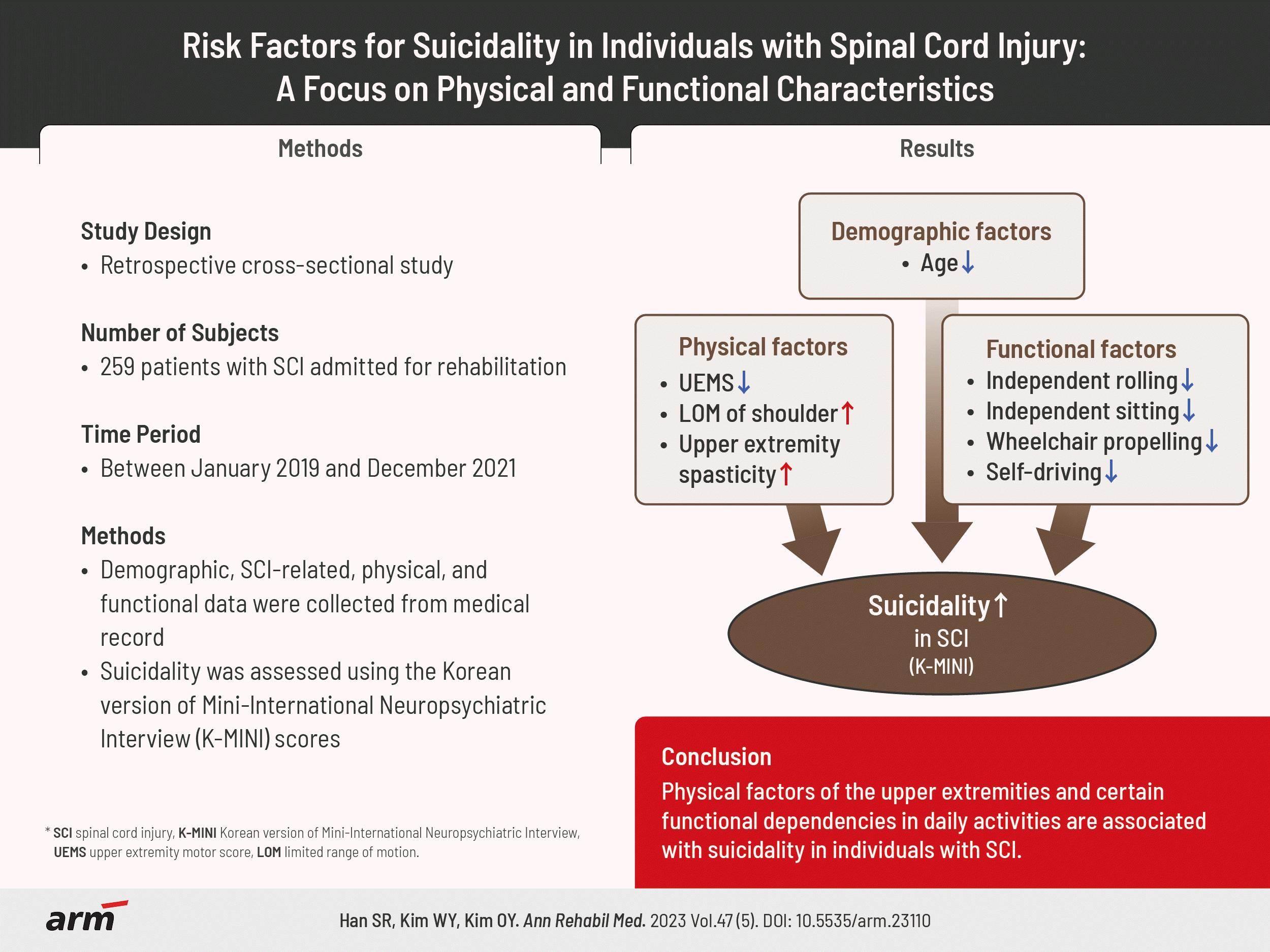Abstract
Objective
Methods
Results
Conclusion
Notes
This study was supported by a grant (code#22-C-04) from the Rehabilitation Research & Development Support Program of the Korea National Rehabilitation Center, Ministry of Health and Welfare, Korea.
Conceptualization: Kim O. Methodology: Han S, Kim W, Kim O. Formal analysis: Han S, Kim W. Funding acquisition: Kim O. Project administration: Han S, Kim W, Kim O. Visualization: Han S, Kim W. Writing – original draft: Han S, Kim O. Writing – review and editing: Han S, Kim W, Kim O. Approval of final manuscript: all authors.
REFERENCES
Fig. 1.

Table 1.
Values are presented as mean±standard deviation or number (%).
SCI, spinal cord injury; AISA, American Spinal Injury Association; UEMS, upper extremity motor score; LEMS, lower extremity motor score; LOM, limited range of motion; FAC, functional ambulation categories.
a)Analysis was conducted on the participants from whom data was available.
Table 2.
| Characteristic | Mean±SD | r | p-value |
|---|---|---|---|
| Demographic factor | |||
| Age (yr) | -0.162 | 0.021* | |
| Sex | |||
| Male | 1.6±3.2 | 0.187 | |
| Female | 2.3±3.7 | ||
| Body mass index (kg/m2) | 0.000 | 0.996 | |
| Education (yr) | |||
| >12 | 1.4±3.0 | 0.234 | |
| ≤12 | 2.0±3.5 | ||
| Current occupation | |||
| Yes | 1.6±3.4 | 0.427 | |
| No | 2.0±3.5 | ||
| SCI related factor | |||
| Duration from injury (day) | 0.036 | 0.615 | |
| Severity of SCI | |||
| Complete injury | 1.7±3.3 | 0.817 | |
| Incomplete injury | 1.9±3.4 | ||
| Neurological level of injury | |||
| Tetraplegia | 2.0±3.9 | 0.271 | |
| Paraplegia | 1.5±2.6 | ||
| Etiology of injury | |||
| Traumatic | 1.7±3.4 | 0.483 | |
| Nontraumatic | 2.1±3.2 | ||
| Physical characteristic | |||
| ASIA motor score | |||
| UEMS | -0.144 | 0.042* | |
| LEMS | -0.083 | 0.246 | |
| LOM of shoulder | |||
| Yes | 2.4±3.9 | 0.097† | |
| No | 1.5±3.0 | ||
| LOM of hip | |||
| Yes | 2.0±3.0 | 0.458 | |
| No | 1.6±3.1 | ||
| Spasticity of upper extremity | |||
| Yes | 2.7±4.6 | 0.089† | |
| No | 1.5±2.8 | ||
| Spasticity of lower extremity | |||
| Yes | 2.1±3.9 | 0.293 | |
| No | 1.5±2.7 | ||
| Functional characteristic | |||
| Rolling | |||
| Independent | 1.3±2.7 | 0.014* | |
| Dependent | 2.7±4.2 | ||
| Come to sit | |||
| Independent | 1.2±2.5 | 0.018* | |
| Dependent | 2.4±4.0 | ||
| Wheelchair propelling | |||
| Independent | 1.2±2.4 | 0.004** | |
| Dependent | 3.1±4.5 | ||
| FAC scale | -0.172 | 0.084† | |
| Self-driving | |||
| Yes | 0.7±1.5 | 0.001** | |
| No | 2.1±3.6 |
SCI, spinal cord injury; SD, standard deviation; AISA, American Spinal Injury Association; UEMS, upper extremity motor score; LEMS, lower extremity motor score; LOM, limited range of motion; FAC, functional ambulation categories; K-MINI, Korean version of the Mini International Neuropsychiatric Interview.
Table 3.
| Factor | Characteristic | B | SE | β | t | p-value |
|---|---|---|---|---|---|---|
| Demographic factor | Age (yr) | -0.03 | 0.01 | -0.16 | -2.32 | 0.021* |
| Physical characteristic | UEMS | -0.03 | 0.02 | -0.14 | -2.04 | 0.042* |
| LOM of shoulder | 0.91 | 0.50 | 0.13 | 1.82 | 0.070† | |
| Spasticity of upper extremity | 1.20 | 0.54 | 0.16 | 2.21 | 0.028* | |
| Functional characteristic | Rolling | -1.42 | 0.50 | -0.20 | -2.87 | 0.005** |
| Come to sit | -1.14 | 0.47 | -0.17 | -2.42 | 0.016* | |
| Wheelchair propelling | -1.87 | 0.52 | -0.26 | -3.56 | <0.001*** | |
| FAC scale | -0.41 | 0.23 | -0.17 | -1.74 | 0.084† | |
| Self-driving | -1.41 | 0.75 | -0.14 | -1.90 | 0.059† |
Reference group: come to sit (0=dependent); LOM of shoulder (0=no); rolling (0=dependent); self-driving (0=no); spasticity of upper extremity (0=no); wheelchair propelling (0=dependent).
SE, standard error; UEMS, upper extremity motor score; LOM, limited range of motion; FAC, functional ambulation categories.
Table 4.
| Factor | Characteristic | B | SE | β | t | p-value |
|---|---|---|---|---|---|---|
| (Constant) | -3.24 | 3.60 | -0.90 | 0.372 | ||
| Demographic factor | Age (yr) | -0.04 | 0.02 | -0.20 | -1.64 | 0.106 |
| Physical characteristic | UEMS | -0.20 | 0.09 | -0.63 | -2.27 | 0.027* |
| LOM of shoulder | 2.26 | 1.02 | 0.33 | 2.21 | 0.031* | |
| Spasticity of upper extremity | 3.33 | 1.42 | 0.47 | 2.34 | 0.023* | |
| Functional characteristic | Rolling | -0.62 | 1.28 | -0.08 | -0.48 | 0.632 |
| Come to sit | 0.29 | 1.17 | 0.04 | 0.24 | 0.808 | |
| Wheelchair propelling | -3.09 | 1.27 | -0.43 | -2.44 | 0.018** | |
| FAC scale | -0.18 | 0.30 | -0.08 | -0.60 | 0.549 | |
| Self-driving | -0.95 | 0.96 | -0.12 | -0.99 | 0.327 |
Reference group: come to sit (0=dependent); LOM of shoulder (0=no); rolling (0=dependent); self-driving (0=no); spasticity of upper extremity (0=no); wheelchair propelling (0=dependent).
F (9, 60)=2.71 (p<0.01), R2=0.289.
SE, standard error; UEMS, upper extremity motor score; LOM, limited range of motion; FAC, functional ambulation categories.




 PDF
PDF Citation
Citation Print
Print




 XML Download
XML Download